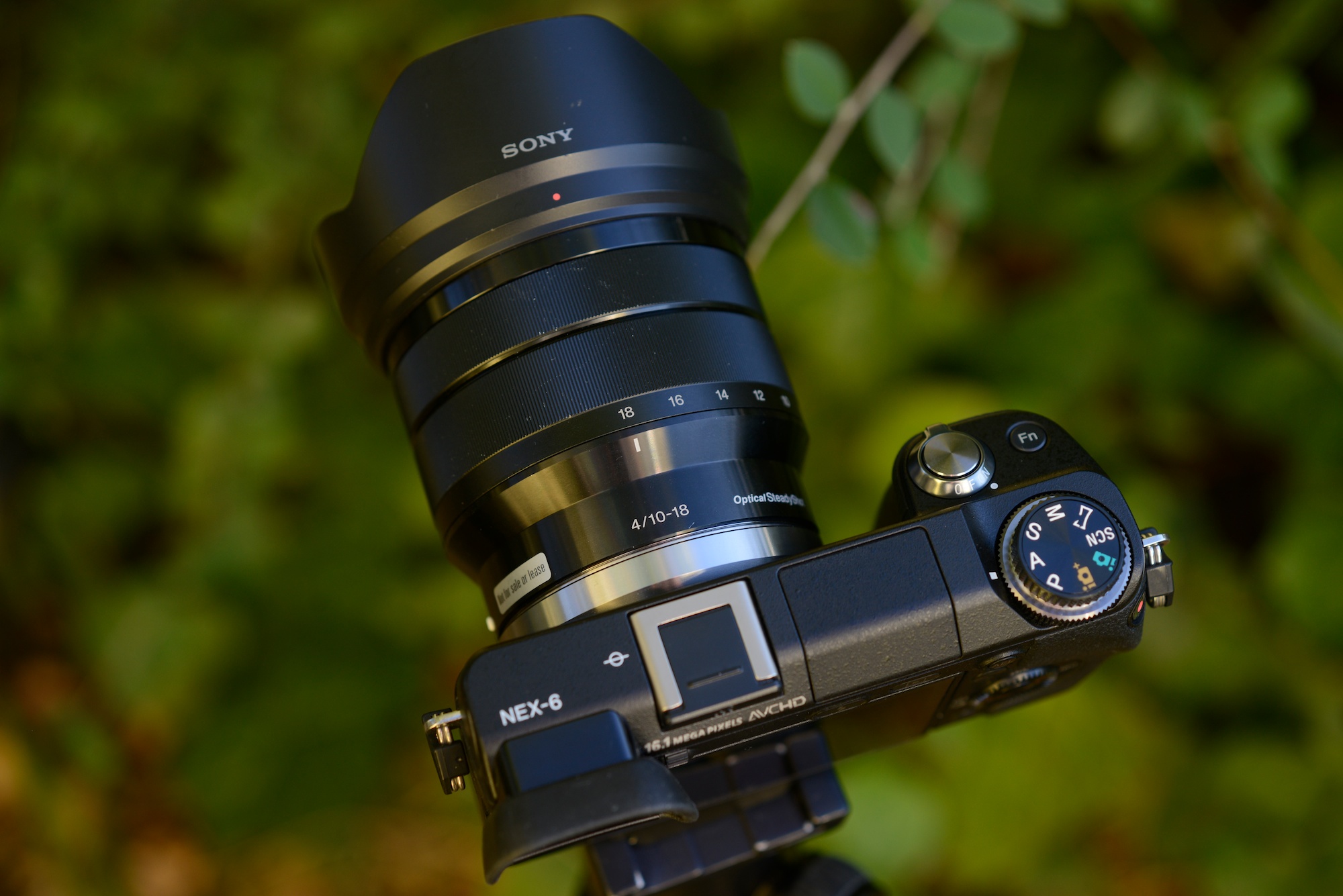Last Updated on 12/31/2012 by Peter Walkowiak
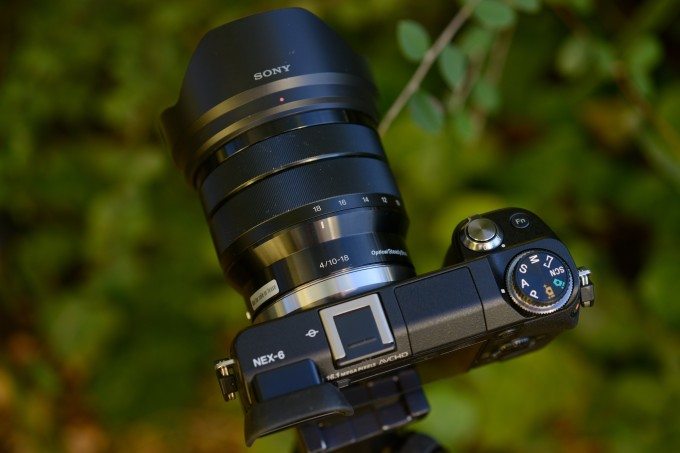
The Sony NEX-6 came out not too long ago and I have been eager to try it and I was very fortunate to get the camera in time for my New York City vacation. Things fell into place and here I was with the new NEX, 50mm f/1.8 and the fresh off the press Sony 10-18mm f/4. There is something about the small size of the Sony that makes one subliminally think that this camera can’t do the heavy lifting of a professional cameras.
With that in mind I flirted with the idea of leaving my beloved Nikon D800 at home just to test myself with a more minimal system. In the end I brought the D800 along for the ride along with a couple of Nikon lenses. The question is do I regret bringing the beast along and was the extra weight worth carrying while walking the city?
[youtube https://www.youtube.com/watch?v=rQoSngx_3hs?rel=0]
Pros and Cons
Pros:
Solid feeling camera with unassuming power.
Sony exclusive features like Sweep Panorama
Mode dials
EVF
Cons:
Applications
Wifi implementation
Slow from cold start to first photo
NEX menu system
Gear Used
Tech Specs
Specifications taken from the B&H Photo Video listing of the item.
| Imaging | |
|---|---|
| Lens Mount | Sony E Mount |
| Camera Format | APS-C (1.5x Crop Factor) |
| Pixels | Actual: 16.7 Megapixel Effective: 16.1 Megapixel |
| Max Resolution | 16MP: 4912 x 3264 @ 3:2 |
| Other Resolutions | 13.6MP: 4912 x 2760 @ 16:9 7.1MP: 3568 x 2000 @ 16:9 3.4MP: 2448 x 1376 @ 16:9 8.4MP: 3872 x 2160 @ 16:9 8.4MP: 3568 x 2368 @ 3:2 4MP: 2448 x 1624 @ 3:2 23MP: 12416 x 1856 15MP: 8192 x 1856 12MP: 5536 x 2160 1 |
| Sensor Type / Size | CMOS, 23.5 x 15.6 mm |
| File Formats | Still Images: JPEG, RAW Movies: MPEG-4, MPEG-4 AVCHD Audio: AAC |
| Bit Depth | Not Specified By Manufacturer |
| Dust Reduction System | Y |
| Noise Reduction | Yes |
| Memory Card Type | Memory Stick Pro Duo Memory Stick PRO HG-Duo SD SDHC SDXC |
| Image Stabilization | Not Specified By Manufacturer |
| Focus Control | |
|---|---|
| Focus Type | Auto & Manual |
| Focus Mode | Single-servo AF (S), Continuous-servo AF (C), Manual Focus (M) , Focus Lock AF Area Mode |
| Autofocus Points | 99 |
| Exposure Control | |
|---|---|
| ISO Sensitivity | Auto, 100-3200 (Extended Mode: 3200-25600) |
| Shutter | Type: Electronic Speed: 30 – 1/4000 sec in Bulb Mode |
| Metering Method | Center-weighted average metering, Multi-zone metering, Spot metering |
| Exposure Modes | Modes: AE Bracketing, AE Lock, Aperture Priority, Auto, Manual, Programmed Auto, Shutter Priority Compensation: -3 EV to +3 EV (in 1/3 EV steps) |
| White Balance Modes | Auto, Cloudy, Custom, Daylight, Flash, Fluorescent, Incandescent, Shade2 |
| Burst Rate | Up to 10 fps for up to 16 frames |
| Performance | |
|---|---|
| Continuous Shooting | Up to 3 fps |
| Self Timer | 10 sec, 2 sec |
| Connectivity | HDMI C (Mini), Micro-USB |
| Software Requirements | Windows: XP (SP3), Vista (SP2), 7 Mac: OS X 10.3 or later |
| Power | |
|---|---|
| Battery | 1x NP-FW50 Rechargeable Lithium-Ion Battery Pack, 7.2VDC |
| AC Power Adapter | AC-UB10 (Included) |
| Operating/Storage Temperature | Not Specified By Manufacturer |
| Physical | |
|---|---|
| Dimensions (WxHxD) | 4.8 x 2.8 x 1.1″ / 12.2 x 7.1 x 2.8 cm |
| Weight | 10.1 oz / 286 g camera only |
Ergonomics
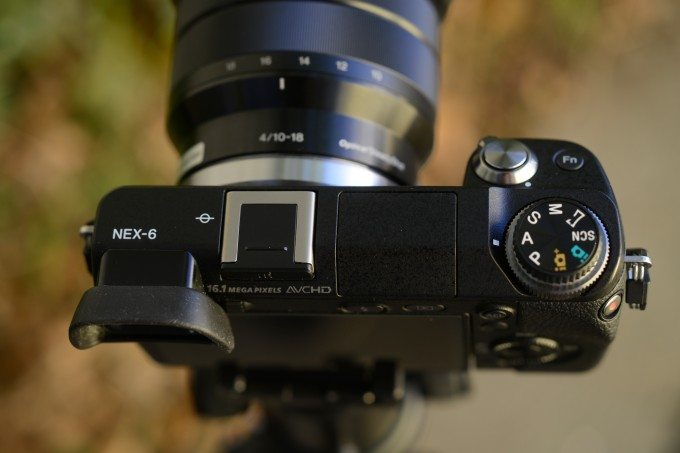
If you have held a Sony NEX camera then you probably familiar with the general weight and feeling of it. The top of the camera contains most of the radical changes, here you will see an EVF, Multi Interface Shoe, Fn button and a mode dial. Atop of this mode dial contains the traditional M,P,A and S settings side by side with Sony’s two automatic modes and Sweep Panorama. Below this dial there will be a second dial which will change based on what mode you are currently in. On the top you may also notice that it has a hidden pop-up flash. The shutter button has a new neighbor and that is a brand new Fn button which can be programmed–more on that later.
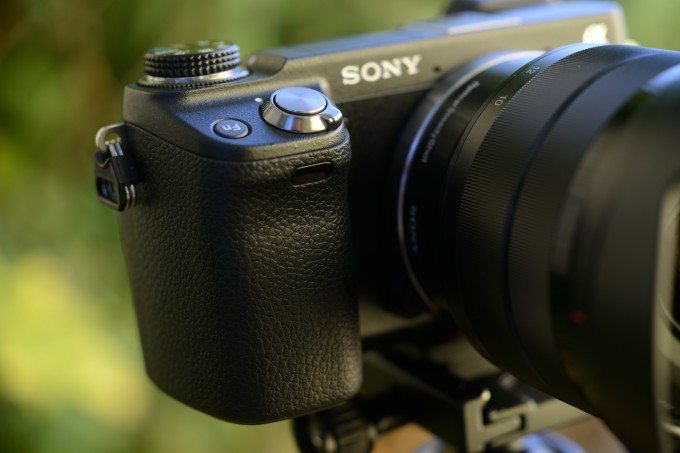
The right side of the camera features a generous grip but no more than the NEX-7. It has enough room for my man paw but all cameras at this size are a bit lacking. The 10-18mm lens I shot with actually has a wide base so that helped to hold it firmly. Buttons are all well within easy reach and the grip and the button layout didn’t require any sort of finger yoga to get used to them.
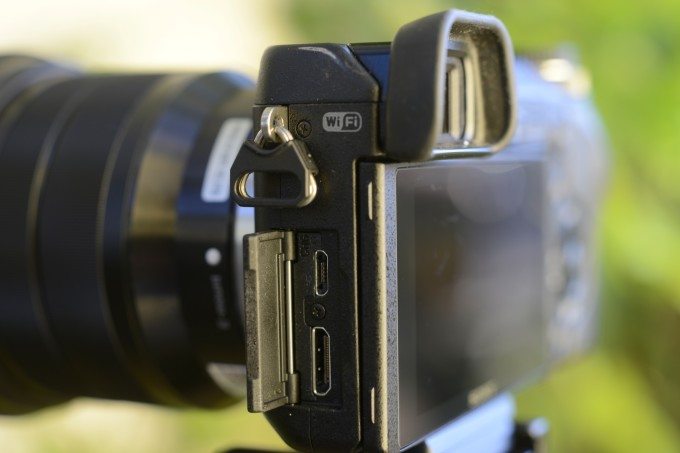
The left side has a single port hatch that reveals HDMI as well as a micro USB port which can be used for importing photos or charging. When the camera is charging there will be the tiniest orange led which appears just above the USB port and requires a direct line of sight to confirm that it’s juicing.
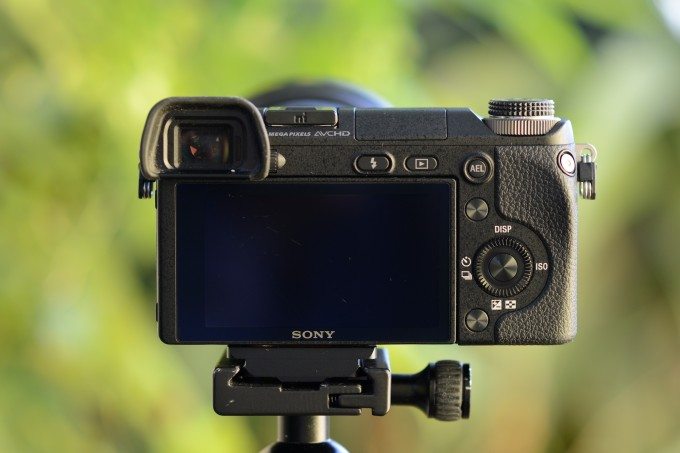
The backside of the camera has a lot of good things going for it with well placed, great feeling buttons. Looking at the back from the left we have the EVF which is the same quality as the NEX-7 and some of the Sony Alpha series cameras. As a side note the EVF has a removable eyepiece which is nice and maybe someday we will see someone make third party replacements (they may already exist). Below the flash on the top center of the back is a button which is a bit recessed and requires a firm(er) press to release the flash from its slumber. To the right of that we have the play back button as well as an AEL button for locking exposure (or it can be configure to do quite a few different things).

A large tilt-able 3″ screen dominates the back and it is sadly not a touch screen, I know there was some mixup and drama when it was released with people assuming it had one because the NEX-5R came with one. I feel that a touch screen may become a crucial part of Sony’s future camera apps. The screen has a thick black border around it which is common with displays that tilt and at first glance the display appears a lot larger than it is. This goes to show how good the blacks are in the display because when its on you just assume that Sony is choosing not to use the left side of the display. Colors are great and reflect exactly what is seen before an image is taken from the EVF. With that said it’s worth the mention that the LCD appears to have a very similar if not the exact same look as the EVF, this includes dancing pixels and blocking in lowlight.
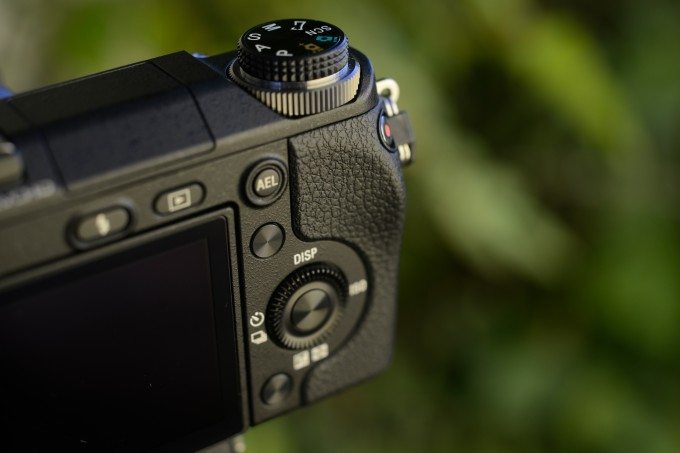
The rest of the dial and buttons on the back are very close to the other cameras in the NEX lineup. Below the AEL button is the menu button, below that a control wheel which has a center button as well as a up, down, left and right button built into the circular dial. The final button on back is called “Soft key B” and it is the bottom most button on the camera just below the control wheel. This button is a wild card with no set label even on the camera itself. By default is is set to “view on smartphone” which is supposed to make it easy to share images from the camera to your Android or iOS device (a lot more on this later). This wildcard can be set to a bunch of different settings but just to name a few they are AF mode, DRO/HDR, zoom, quality, ISO, Creative Style, MF assist and believe it or not Download an application.
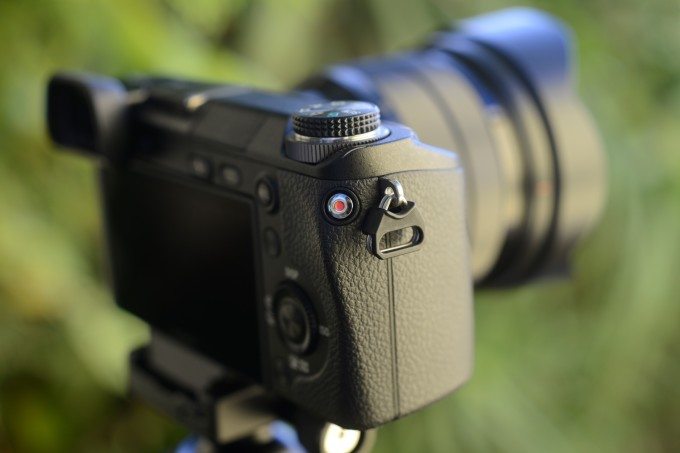
Oh wait–there’s more! I said the final button was the soft key on the back but one more remains but doesnt belong to a side, it resides on the back right corner. The placement of the movie record button is one that I love but I also strongly dislike it. I went to record several times and cocked back my thumb awkwardly to reach for the record button. Sometimes I was successful in placing my finger but most times I had to fuss with the neck strap being in the way. I ended up pulling the camera more away from my body to tighten the neck strap which in turn made access easier. I never saw the negative to having a record button on the top or on the back like previous NEX cameras. I’ll leave it up to you the reader to decide if it’s well placed.
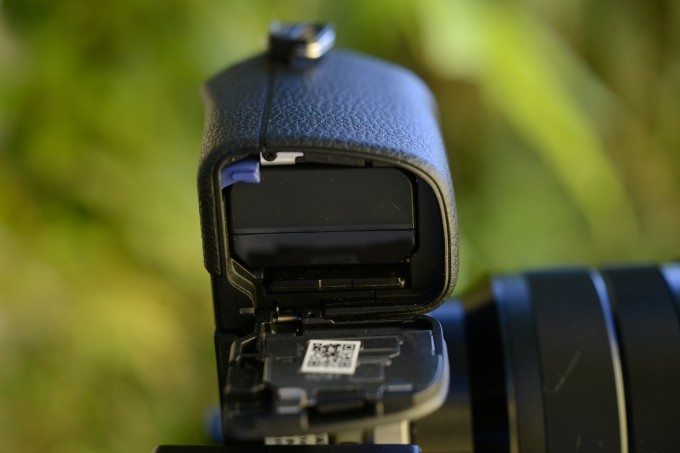
The bottom of the camera is quite barren compared to the rest of the camera and it has just a tripod socket and cover which houses a battery and SD card.
Build Quality
The body is very sturdy and in my opinion there isn’t a cheap feeling part on the camera. The buttons that require more force do and the more common buttons are easy to press and responsive. The bottom battery door opened a couple times on its own (probably by rubbing against me) and the port hatch on the left side has a really nice clean snap open and close.
In my day bag I carried three camera systems and it included the NEX-6 as well as my personal Nikon V1 and D800 cameras. The NEX was treated better than my personal gear but it still suffered scratches on the display and top mode dial. This also happened to me when I was reviewing the Sony RX100 also but I assumed it was a one time glitch in the universe–apparently its may be more common than I had assumed. My Nikons have hard glass over their displays which makes them less vulnerable but not impenetrable, after four years of misuse my D700 has some dust under the screen but not a single scratch. This also goes with the top dial has some paint scratched off of the sweep panorama setting, I have yet to see this on my other cameras. I do understand that the cameras are in completely different classes.
I am going to section of the review with a reminder that these are not cameras to me, they are tools and like a hammer it is not misused but used and in my case quite heavily. I understand marks will happen but in this case you should consider a Sony made screen protector.
Autofocus
Mirrorless cameras are quick (besides the Canon M) and the NEX-6 is no exception. In 80% of cases the camera nails the focus instantly without hunting. This camera is one of the first few cameras from Sony offering their hybrid AF which combines phase and contrast focussing which is supposed to give you a faster more accurate shot. Phase AF will help the camera quickly snap to a scene or moving subject where the contrast AF helps with precision. On launch day, my mind read it as the hybrid AF would make the camera to focus faster; but after some use I’m not sure that is the case at all. This was my first extended period with an NEX camera so it may be improved but I noticed nothing special. As I mentioned earlier, there was a good 20% of photo attempts where the camera would hunt a little, sometimes in low light (dusk) and other times where there was just no excuse in broad daylight. This hunting was seen with both the 50mm and 10-18mm lenses. The camera overall kept up with my Nikon cameras but none of them were a clear winner during the day but as expected my D800 was the victor at night. When modern cameras focus speeds are milliseconds apart I find that it is important to know how much hunting a camera requires before locking the subject in.
Ease of Use
Sony has been a leader when it comes to intelligent automatic modes as well as teaching its users how to take better images. The NEX-6 comes with two different automatic modes where one sets exposure on its own and the other combines automatic exposure combined features like handheld twilight or twilight portrait if a face is detected.
[youtube https://www.youtube.com/watch?v=oxVX1-GGk3I?rel=0]
Menu systems are usually where people start to argue and pick sides, for example myself being a Nikon shooter am not a fan at all of the Canon menus. To me the companies build them completely the opposite just to make them different and worrisome, same goes for focus directions etc. Now on the the Menus of the NEX system, they may actually take the crown for the worst menu system ever put onto a camera, there are six different areas in which they are all organized. One of them is labeled setup, now if you dare to enter this deep pit of endless settings you will be amazed how difficult it is to find the one you were looking for. In the video above I show how many items can be found within this one section. All I ask for is that Sony adopts their RX100 menus or even the Alpha system to the NEX series, I have zero complaints about these. Picking on the menu system isn’t fair because Sony does an excellent job of making it easy to customize the buttons found on the camera so you find yourself menu hunting less.
Camera customization is something that Sony excels at and may even be best at it. This camera has three buttons that can be customized, Fn on top, soft “b” key and the AEL button. The Fn button can be set to manage multiple settings easily so you can avoid those dreaded menu searches.
Alpha App Implementation
[youtube https://www.youtube.com/watch?v=2EMpWUs_QlY?rel=0]
Not Alpha as in the line of Sony cameras but Alpha in the way you would refer to buggy pre-release software. Yup, that’s right folks I am about to go into a full blown rant so if you are really interested in my opinion of Sony’s app implementation please read on.
There are a cameras out there that are starting to ship with Android and more will come next year I’m sure. This is going to be without a doubt a huge part of the future of digital. Well like how video swept over all models from consumer to professional so will apps and Wi-Fi. Sony has (had?) a chance here to spark a new market and own it like they do with their far superior automatic modes. Unfortunately it feels like apps were a last minute add-on to the camera and they are awful.
Not only bad in the way they run but also it seems they ran out of ideas, they took a great free feature from the other models and made it a $5 app in their play memories store. I’m looking at you “Multi-Shot NR”. I can’t speak to how good or bad the Sony Play Memories Mobile app is for Android but I assure you it is awful on iOS. Oh boy does it earn it’s 2.5 star rating on the App Store. The least of my worries with it is that it hasn’t been updated to support my iPhone 5. Scrolling through the reviews of the app you will see various complaints which I can say I have experienced most of them. First to connect to your phone to the camera you must join the NEX’s Wi-Fi network which is password protected, not a big deal but doing so disconnects your from the world. On top of that the password and network change so you will find yourself randomly having to reconnect phone to the camera. A better way to do this would have been to take the Eye-Fi approach and add a network profile to the phone, doing so would have eliminated steps, made it quicker and less frustrating. If you are going to either transfer photos from the NEX to your phone or control the camera using the Play Memories app you will be deeply saddened when you notice that it only transfers 2MP images. This is the only drawback that has a cure! A lot of people including myself ranted and complained about this before I noticed that you can save the original when the setting is changed not in the settings in the app but under the phone settings. Overall the whole process from using the apps to buying the apps themselves is very time consuming. When it comes to camera control at this point you can only see the liveview on the camera and take a picture. There is no way to change settings within the Sony app or record video, simply a preview and a shutter button. A positive is that there is almost zero lag between the two screens, I have seen Nikon D600 and GoPro Hero 3 demos and they are much much laggier.
When it comes to installing the apps you have two choices, plugging the camera into the computer and installing apps over USB or use the slow antiquated App Store on the NEX. When entering letters on the camera you have to do it one by one like a game system, scrolling to each letter and pressing return. Calling it an App Store is very generous and realistically it reminds me of the very very first mobile websites, loading the app pages or trying to send a photo to Facebook will reveal slow loading mobile page that is built as an attempt to keep consistency throughout the camera. I would like the Play Memories app to pair with the phone in a way where you could use your phone either to install apps on the camera or control the keyboard, one can dream.
In conclusion there might as well not be Wi-Fi or apps on this camera, to me this would better used as a internal prototype than a pushed public feature. To be successful I feel that Sony is going to have a public app roadmap or maybe crack the security door open for exclusive innovative developers. I know Sony fears giving too much away when it comes to apps but they shouldn’t take away great features and then turn around to sell them at a cost. I am looking forward to the future of apps on cameras.
Image Quality
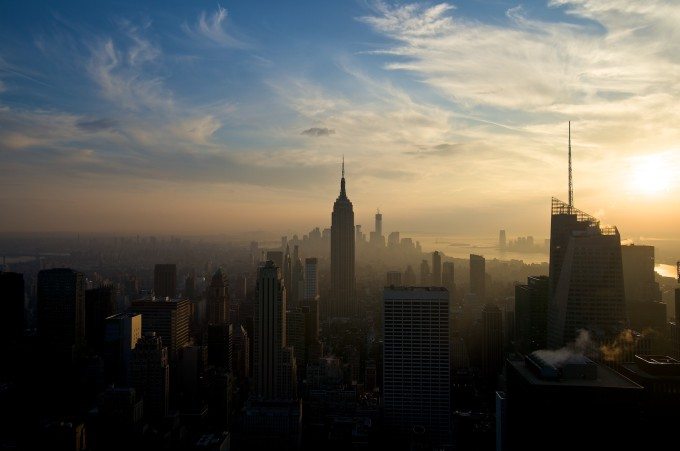
Out and about during the day the NEX-6 is a king in its realm, the camera combined with good lenses which I had provided me with stunning results. The images are quite sharp and I feel 16mp is the best place for current APS-C sensors due to a fair exchange of noise and detail. This is what makes me consider this the best NEX that money can buy because the 24mp sensor in the NEX-7 has never quite impressed me. This camera still has plenty of detail and isn’t nearly as noisy at higher ISOs.
A minor quibble with the NEX line is I wish they could somehow fit stabilization into the tiny camera. This would enable a plethora of great lenses to take a step into the modern age and give them new life, this is one of the things that make their Alpha line so great.
The Sony may fall short when compared to the recent Fuji XE-1 and its sensor but where that camera cannot compete is technology in the camera. Here at the site we have found that the XE-1 seems to capture more detail in the highlights where the NEX-6 does a better job with the shadows. Great tech improvements is what has set Sony apart the last few years with features like in Sweep Panorama and HDR.
HDR


Sweep Panorama
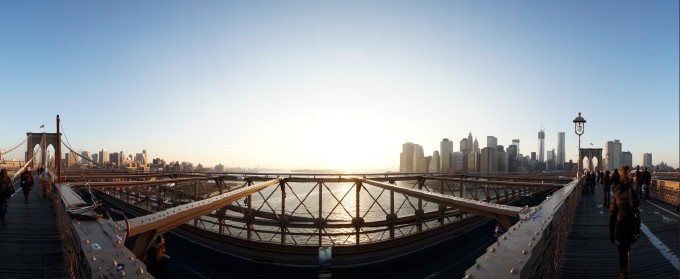
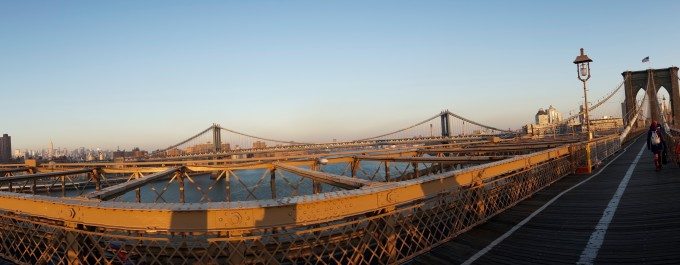
The camera packs a lot of new tech but the sensor in the NEX-6 has been proven, It is the same sensor as the one in the previous 5N (with exception to the AF points on the sensor) and this sensor has been proven as a great performer. I used the camera a lot in Auto ISO and that is from ISO 100-3200. I couldn’t find the ability (if there even is one) to change the max ISO but I would have preferred it capped around 1600. Unless mentioned assume that these images are straight of the camera with no editing. I tend to believe that unedited images show more of the camera than edited ones, editors are always going to have different abilities and you should now how they look as if you just took them.
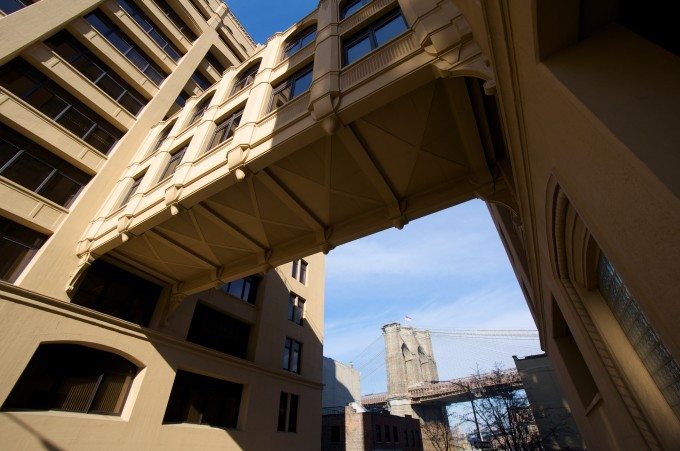


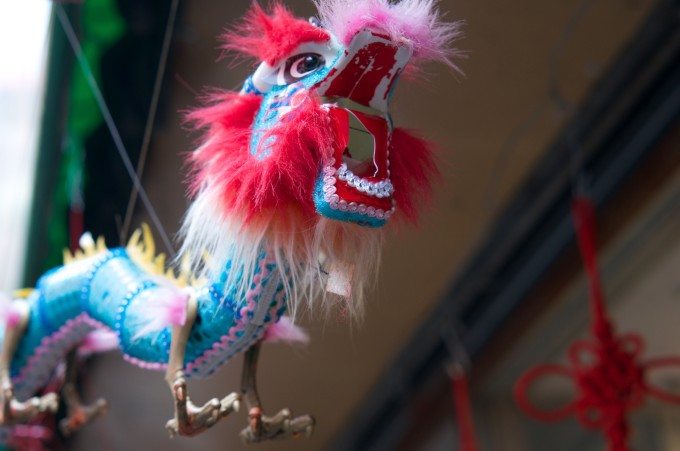

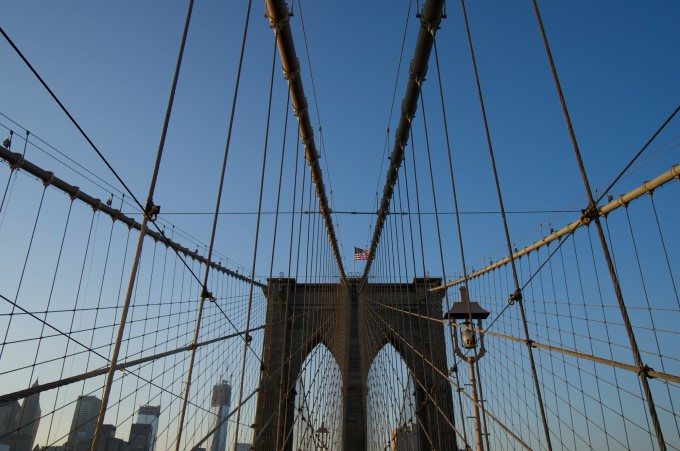

Here are a few samples from ISO 1600, 3200 and 6400. I am sure there are some miracle workers out there but I prefer to spend more time in the field than in front of the computer. As I mentioned these images are directly from the camera unless otherwise mentioned.
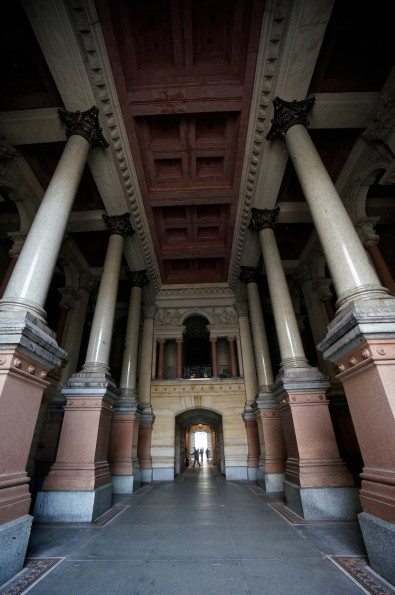

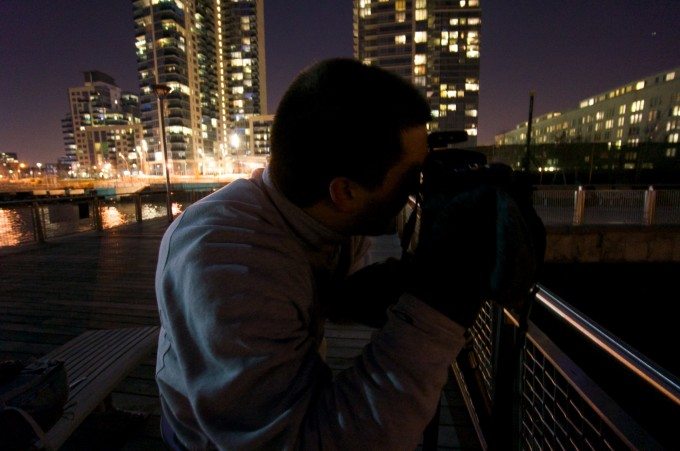
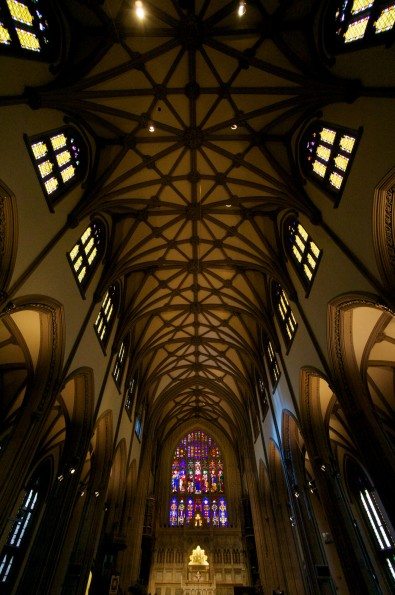
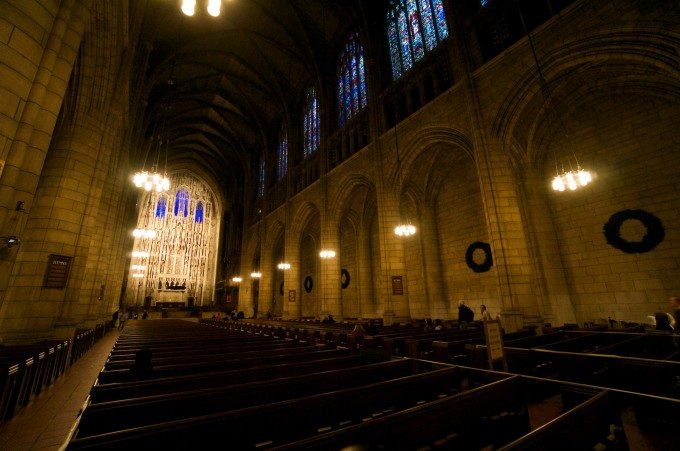
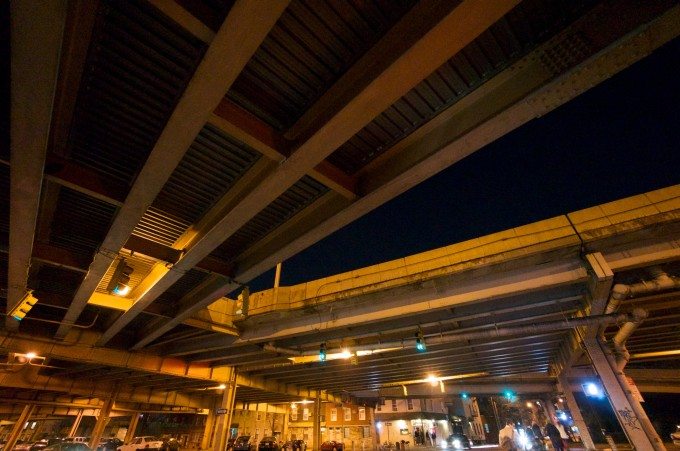
High ISO Results

Now we should keep in mind before we start peeping these images that these are in no way precise, different lenses, focal lengths and metering inside of the cameras. All the cameras were set to the same ISO and in aperture priority at f/8. Honestly all of the cameras are quite good and these 100% samples from each camera look impressive. I was running out of light and the time with the camera so the images were shot exactly as the sun was setting, enjoy.
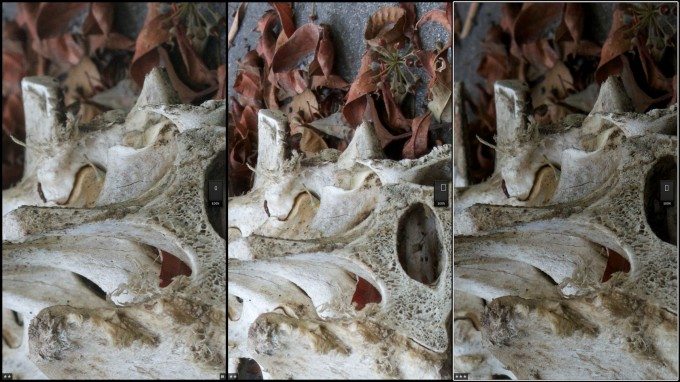
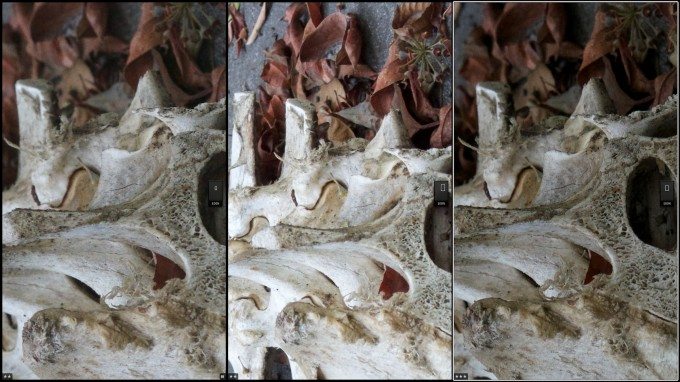
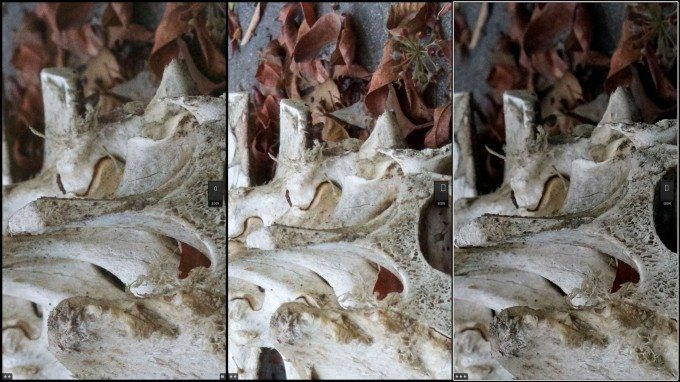
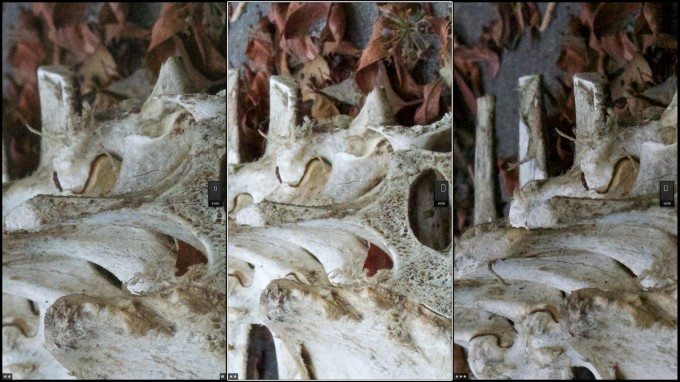
These are crops from the same exact images as above except these are all from the bottom left of the frame which may help to show noise patterns. Due to the different sensors in each cameras DOF drastically different.
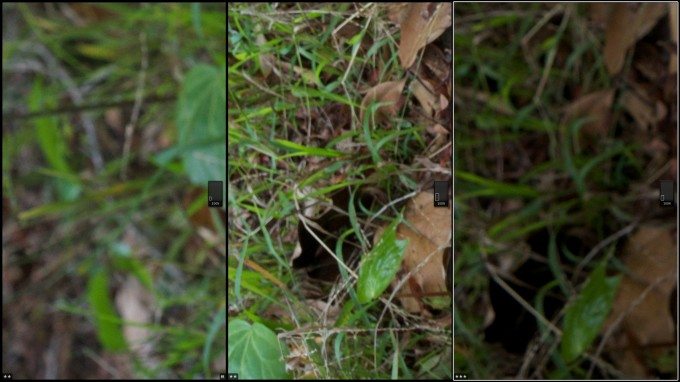
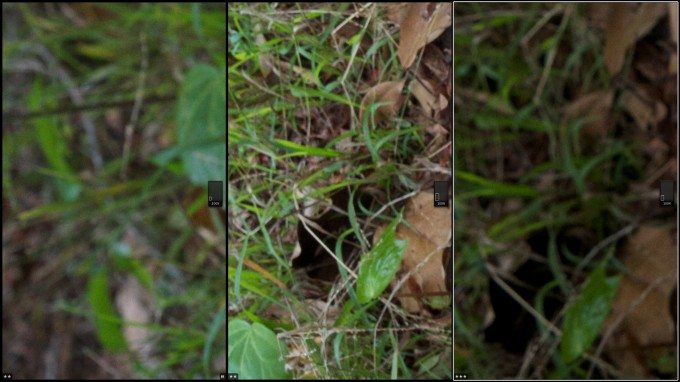
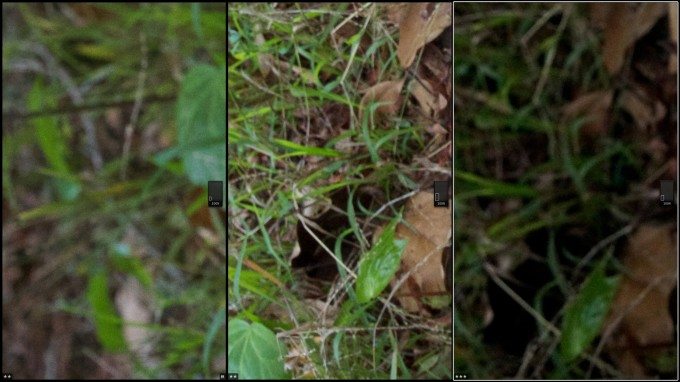
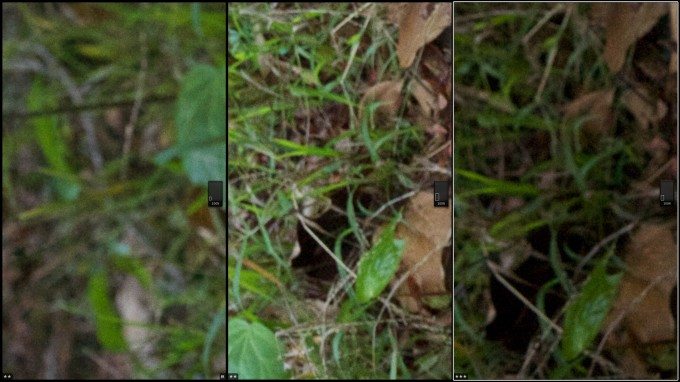
I think these tests were worse than I thought or the Nikon V1 surpassed my expectations because I expected it to look bar far the worst out of the tests, somehow science is being defied here. I have previously mentioned that in real life usage I would stick to ISO 1600 and below with the NEX-6 but if you need you can use ISO 3200 and get by with proper noise reduction software.
RAW File Versatility
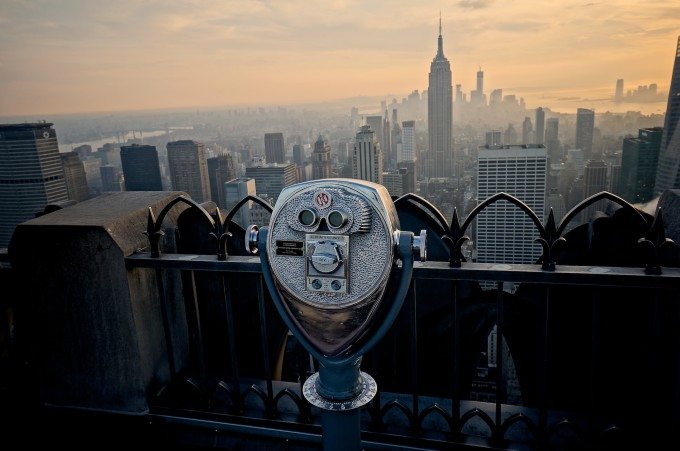
The camera has great out of camera JPEGs and I honestly wouldn’t have minded printing quite a few of them as-is and even our own Chris Gampat loved the images out of the camera compared to the X Pro 1. As we all know JPEG files don’t have that much flexibility and when it comes down to editing, RAW images gives us more room to push and pull. The NEX-6 certainly did not let me down when I took the above image and tweaked it in Aperture. Well exposed low ISO images behave very well but as you would expect images that show noise tend to go from bad to worse when editing. A quick reminder that when it comes to noise NIK recommends that you use should use noise removal software as the first step in your workflow.
If you are thirsty for NEX-6 samples and opinions from the staff you can find an early impressions overview by Chris here.
Video Quality
[youtube https://www.youtube.com/watch?v=UxZNzWl8M40?rel=0]
(Sample video can also be found on Vimeo)
Due to the nature of a pre-production NEX I had some database issues with a few memory cards that I used so I didn’t have much video left over to share. I recorded a bit of video and I am a fan of what I see. I typically shoot the video how I want it and I leave it as is most of the time in post. The video looks very sharp on my 27″ display and I cannot see any artifacting or blocking in the gradations. For those of you who want to video edit make sure you have a decent computer to handle AVCHD footage, FCPX works wonderfully for me but I cringe at the FP7 days where I had to import and convert all of the footage. Overall this camera would work great as a b cam but I can’t see anyone doing serious work with this due to the lack of microphone and headphone jack. You can always use an external record and pair the audio in post but I feel most NEX users will just use the function casually.
Conclusion
What a time we live in, I have all of the features I could have ever dreamed of but I’m still bitching because it’s not good enough. When it comes to being a camera it is amazing, I loved my time with the NEX-6. When this camera came out and I saw the spec list I thought this is it, this is the camera I have been waiting for. I have never wanted the NEX-7 because I am a lowlight shooter and in my opinion that sensor was never any good passed ISO 1600. I also knew that an EVF was required for me to function without steam coming out of my ears so that meant every other NEX camera just wasn’t an option. So here I was sitting with the perfect NEX kit on a jet plane on its way to New York City.
Also beside me was my Nikon D800 with almost the same exact focal length lenses as the NEX kit. I decided to play it safe and bring it because I was worried that the NEX wouldn’t achieve the detail I wanted from my journey. I look at the price spent on every vacation and expect to get an image (or images) worth that to me. In the end was I happy I brought the D800 along for the ride? Did I need it or was the really anything it did that much better to justify the hassle?
Well as you may have guessed, in the end I was very grateful that my D800 joined me. I know this isn’t a fair comparison because they are in no possible way a competitor but listen to my reasoning. I see the NEX-6 as either a second backup body or a step up camera as an upgrade. In my instance it would fall under the backup body or possibly a travel companion. Amongst it’s class it may very well be the best bang for your buck mirrorless camera but stacked against just the metering of my Nikon it can’t compete.
This was also my first chance to spend quality time with an EVF, I loved it but my brain fought with me like a 5 year old the whole trip. I love the optical viewfinder of a full frame camera and even though it in no way is a realistic idea of what my image looked like, I still find it more pleasant. When I was shooting the the NEX I would complain that half the scene is dark and I couldn’t see the whole scene because it was metered for the sky or vice versa. This gave me trouble seeing objects moving in and out of the frame so it made it hard to frame the way I imagined. On the computer or during playback I would notice peoples heads in the bottom of my image which I didn’t see while taking the image. If there was a mode which didn’t meter the scene maybe I would be more into that. I do have to say that it was quite relaxing to see the scene exposed electronically before I pressed the shutter, it’s practically reverse chimping. I would find myself checking exposure far less and enjoying my time more, using the camera to get the shot then quickly returning to enjoy the world.
I love the image quality and I suppose I have been horribly spoiled with full frame but that would not hold me back from recommending this camera to others. I guess personally I have two extremes, a mode where I want to get the best image possible of a moment that I will never see experience again and another that is laid back and is okay with a smartphone camera. In the end if I wanted a small camera, which has an EVF, quick AF, affordable lenses and a generous amount of pixels this is the best camera for your money.
Please Support The Phoblographer
We love to bring you guys the latest and greatest news and gear related stuff. However, we can’t keep doing that unless we have your continued support. If you would like to purchase any of the items mentioned, please do so by clicking our links first and then purchasing the items as we then get a small portion of the sale to help run the website.


